The Human Touch
 Humans are responsible for causing many changes in the environment that hurt animals and plant species. We take up more space on Earth for our homes and cities. We pollute habitats. We illegally hunt and kill animals. We bring exotic species into habitats. All of these activities take resources and habitats away from plants and animals. Humans are responsible for causing many changes in the environment that hurt animals and plant species. We take up more space on Earth for our homes and cities. We pollute habitats. We illegally hunt and kill animals. We bring exotic species into habitats. All of these activities take resources and habitats away from plants and animals.
Human activity often changes or destroys the habitats that plants and animals need to survive. Because human populations are growing so fast, animals and plants are disappearing 1,000 times faster than they have in the past 65 million years. Scientists estimate that in the 21st century 100 species will become extinct every day.
Natural Extinction 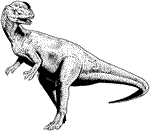 Animals and plants have always had a hard time surviving. Scientists estimate that over two thirds of the animals and plants that once lived on Earth are now extinct. Animals and plants have always had a hard time surviving. Scientists estimate that over two thirds of the animals and plants that once lived on Earth are now extinct.
Animals became extinct in the past for a wide variety of reasons. In some cases, competition for resources among animals led to extinction; in other cases, environmental changes caused extinction.
Scientists think dinosaurs became extinct because a meteorite struck the Earth and caused changes in the environment that the dinosaurs and other animals and plants couldn't adapt to.
Struggling to Survive Some animals are endangered for different reasons at different times. 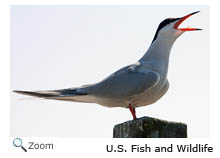 In New Hampshire, the common tern nests on the Isles of Shoals. The Isles of Shoals are an ideal nesting site because there are no natural mammalian predators, and the waters surrounding the Isles provide fish for the terns. In New Hampshire, the common tern nests on the Isles of Shoals. The Isles of Shoals are an ideal nesting site because there are no natural mammalian predators, and the waters surrounding the Isles provide fish for the terns.
Although the conditions on the Isles of Shoals are good for nesting common terns, changes over the years have impacted the common tern population.
When the first settlers came to New Hampshire in the 1600s, they used the Isles of Shoals as a base camp for fishing expeditions, and eventually a small population of settlers lived on the islands year-round. These settlers brought livestock and domestic animals like dogs and cats with them. Some of these animals, like cats, killed common terns. Other animals, like cows and horses, grazed on the islands and disturbed common tern nesting sites. The settlers also disturbed the nesting sites, hunted the birds, and took their eggs. Even with all this activity, the common tern population was still healthy.
It wasn't until the late 1800s that the common tern population became seriously endangered for the first time. In the late 1800s and early 1900s, feathers were very fashionable, especially on ladies hats. The feathers of birds like the great blue heron, the snowy egret, and the common tern were especially valued. The feather trade almost lead to the extinction of a number of native North American birds. In 1918, the United States Congress passed the Migratory Bird Treaty Act which protected migratory birds and their nesting sites and the bird populations began to recover.
Just as the common tern population began to recover on the Isles of Shoals, the birds were faced with a new challenge. In the mid-part of the 20th century open landfills, increases in waste from the fishing industry, and human food waste from restaurants and homes began attracting more and more gulls to New Hampshire's seacoast. These gulls began competing with the common terns for habitat, and they also preyed on common tern chicks and tern eggs. Things got so bad that by the early 1950s the common tern population on the Isles of Shoals had disappeared.
In 1997, the Audubon Society of New Hampshire and the NH Fish and Game Department began creating safe nesting sites for the common tern on White and Seavey Islands. The safe nesting sites use decoys to attract common terns and loud noise to drive away the sea gulls! In the first year of the project, six pairs of common terns nested. Today, there are over 2,500 nesting pairs of common terns on the Isles of Shoals. The safe nesting place has also attracted some roseate tern and arctic tern pairs!
|
|
|
|
Longing for Lupine  Some animals, like the Karner blue butterfly, are endangered because they need very special environments to survive. Some animals, like the Karner blue butterfly, are endangered because they need very special environments to survive.
The Karner blue is dependent on wild lupine. Wild lupine is a plant that grows in pine and oak barrens in the Northeast and Midwest. It is the only known food source of the larvae of the Karner blue. Without this plant the butterfly can't survive.
Wild lupine grows best in sandy soils where forest fires occasionally clear out old vegetation. Fire helps keep shrubs low and clears the areas of plants like aspen and maple that can take over a habitat and create too much shade for lupine to grow.
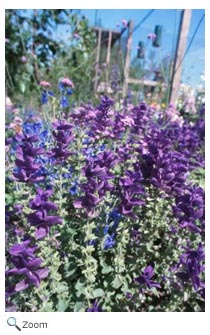 Karner blues rely on lupine for their whole life cycle. They attach their eggs to the stems of the plants, and newly hatched caterpillars eat the leaves of the plant. If wild lupine doesn't grow, the Karner blue doesn't survive. Because humans control wildfires, lupine isn't as abundant as it used to be. Lupine is also killed by pesticides. Because lupine is harder to find, the population of Karner blues has drooped by 99% in the last two decades. Karner blues rely on lupine for their whole life cycle. They attach their eggs to the stems of the plants, and newly hatched caterpillars eat the leaves of the plant. If wild lupine doesn't grow, the Karner blue doesn't survive. Because humans control wildfires, lupine isn't as abundant as it used to be. Lupine is also killed by pesticides. Because lupine is harder to find, the population of Karner blues has drooped by 99% in the last two decades.
Multiple Factors 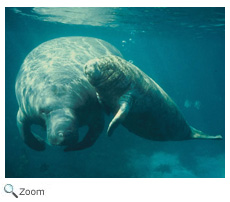 Some animals are endangered because of a combination of natural and man-made causes. Some animals are endangered because of a combination of natural and man-made causes.
The West Indian manatee is an endangered aquatic mammal that lives in rivers, estuaries, canals, and saltwater bays.
Manatees need warm water to survive. In the winter, they live in southern Florida and parts of Georgia. In the summer, they can migrate as far north as Virginia and west to Louisiana. Sometimes manatees die because they don't migrate back to warm water soon enough.
There are currently a little under 2,000 manatees in Florida. Every year about 150 die. Manatees are often killed when they are hit by boats. Manatees can also die when they get caught in fishing nets. Manatees only give birth every two to five years and they only have one calf at a time. Because their reproduction rate is so low and mortality rates are high, manatee populations are endangered.
Unfair Competition
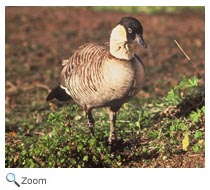 Some animals are endangered because exotic or non-native species have been introduced into their habitats. In Hawaii, the Nene goose is in danger, in part, because of the mongoose. The mongoose was brought into Hawaii by planters to help control rats in sugar cane fields. The planters didn't realize that rats are nocturnal and the mongoose hunts in the day. The mongoose found other sources of food like eggs from nesting birds, including the Nene goose. The Nene goose used to be found all over Hawaii. There are now less than 800 left in the state. Some animals are endangered because exotic or non-native species have been introduced into their habitats. In Hawaii, the Nene goose is in danger, in part, because of the mongoose. The mongoose was brought into Hawaii by planters to help control rats in sugar cane fields. The planters didn't realize that rats are nocturnal and the mongoose hunts in the day. The mongoose found other sources of food like eggs from nesting birds, including the Nene goose. The Nene goose used to be found all over Hawaii. There are now less than 800 left in the state.
|


 Animals and plants have always had a hard time surviving. Scientists estimate that over two thirds of the animals and plants that once lived on Earth are now extinct.
Animals and plants have always had a hard time surviving. Scientists estimate that over two thirds of the animals and plants that once lived on Earth are now extinct. 



